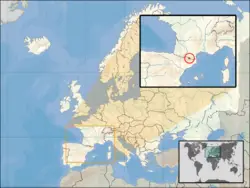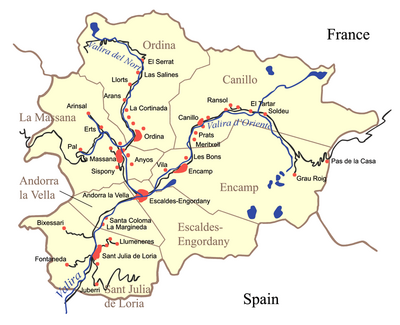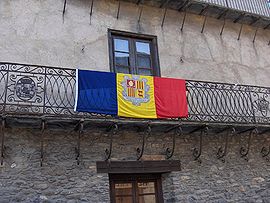Andorra
| Principat d'Andorra Principality of Andorra | |||||
| |||||
| Motto: "Virtus Unita Fortior" (Latin) "Virtue United is Stronger" | |||||
| Anthem: El Gran Carlemany, Mon Pare (Catalan) The Great Charlemagne, my Father | |||||
| Capital | Andorra la Vella 42°30′N 1°31′E | ||||
|---|---|---|---|---|---|
| Largest city | capital | ||||
| Official languages | Catalan | ||||
| Government | Parliamentary co-principality | ||||
| - French Co-Prince | Nicolas Sarkozy | ||||
| - Episcopal Co-Prince | Joan Enric Vives Sicília | ||||
| - Head of Government | Albert Pintat Santolària | ||||
| Independence | |||||
| - Paréage | 1278 | ||||
| Area | |||||
| - Total | 468 km² (193rd) 181 sq mi | ||||
| - Water (%) | 0 | ||||
| Population | |||||
| - 2007 estimate | 71,822 | ||||
| - 2006 census | 69,150 | ||||
| - Density | 154/km² 393/sq mi | ||||
| GDP (PPP) | 2005 estimate | ||||
| - Total | $2.77 billion | ||||
| - Per capita | $38,800 | ||||
| Currency | euro (€)1 (EUR)
| ||||
| Time zone | CET (UTC+1) | ||||
| - Summer (DST) | CEST (UTC+2) | ||||
| Internet TLD | .ad2 | ||||
| Calling code | +376 | ||||
Andorra (Catalan: Andorra), officially The Principality of Andorra (Catalan: Principat d'Andorra) is a small landlocked country in southwestern Europe, located in the eastern Pyrenees mountains and bordered by Spain and France. Once isolated, it is currently a prosperous country mainly because of tourism and its status as a tax haven. It has the highest life expectancy in the world, at 83.52 years (2007 est).[1]
Origin and history of the name
The name "Andorra" is of unknown origin but (according to Joan Coromines) clearly pre-Roman. Many of the local toponyms are of Iberian-Basque origin.
History
Tradition holds that Charles the Great (Charlemagne) granted a charter to the Andorran people in return for their fighting the Moors. Overlordship of the territory passed to the local count of Urgell and eventually to the bishop of the diocese of Urgell. In the eleventh century a dispute arose between the bishop and his northern neighbor over Andorra.
The conflict was resolved in 1278 by the signing of a paréage, which provided that Andorra's sovereignty be shared between the count of Foix (whose title would ultimately transfer to the French head of state) and the bishop of La Seu d'Urgell, in Catalonia, Spain. This gave the small principality its territory and political form.
Andorra was briefly annexed to Aragon twice, in 1396 and 1512.
Over the years the title passed to the kings of Navarre. After Henry of Navarre became King Henry IV of France, he issued an edict (1607) that established the head of the French state and the Bishop of Urgell as co-princes of Andorra.
In the period 1812–13, the First French Empire annexed Catalonia and divided it in four départements. Andorra was also annexed and made part of the district of Puigcerdà (département of Sègre).
Andorra declared war on Imperial Germany during World War I but did not actually take part in the fighting. It remained in an official state of belligerency until 1957.[citation needed]
In 1933 France occupied Andorra as a result of social unrest before elections. On July 12, 1934, an adventurer named Boris Skossyreff issued a proclamation in Urgell, declaring himself Boris I, sovereign prince of Andorra, simultaneously declaring war on the bishop of Urgell. He was arrested by Spanish authorities on July 20 and ultimately expelled from Spain. From 1936 to 1940, a French detachment was garrisoned in Andorra to prevent influences of the Spanish Civil War and Franco's Spain. Francoist troops reached the Andorran border in the later stages of the war.
During World War II, Andorra remained neutral and was an important smuggling route between Vichy France and Spain.
Given its relative isolation, Andorra has existed outside the mainstream of European history, with few ties to countries other than France and Spain. In recent times, however, its thriving tourist industry along with developments in transportation and communications have removed the country from its isolation and its political system was thoroughly modernized in 1993, the year in which it became a member of the United Nations.
Politics
Andorra is a co-principality with the President of France and the Bishop of Urgell, Spain as co-princes, in a duumvirate. The politics of Andorra take place in a framework of a parliamentary representative democracy, whereby the Prime Minister of Andorra is the head of government, and of a pluriform multi-party system. Executive power is exercised by the government. Legislative power is vested in both the government and parliament. The Judiciary is independent of the executive and the legislature.
Responsibility for defending Andorra rests with Spain and France. Andorra currently has no military force.
Parishes
Andorra consists of seven municipalities / regions, known as comuns ("commons", singular comú):
- Andorra la Vella
- Canillo
- Encamp
- Escaldes-Engordany
- La Massana
- Ordino
- Sant Julià de Lòria
Geography
Befitting its location in the eastern Pyrenees mountain range, Andorra consists predominantly of rugged mountains of an average height of 1996 meters with the highest being the Coma Pedrosa at 2946 meters. These are dissected by three narrow valleys in a Y shape that combine into one as the main stream, the Valira river, leaves the country for Spain (at Andorra's lowest point of 870 m).
Andorra's climate is similar to its neighbors' temperate climates, but its higher altitude means there is on average more snow in winter and it is slightly cooler in summer.
Economy
Tourism, the mainstay of Andorra's tiny, well-to-do economy, accounts for roughly 80% of GDP. An estimated 9 million tourists visit annually, attracted by Andorra's duty-free status and by its summer and winter resorts. Andorra's comparative advantage has recently eroded as the economies of adjoining France and Spain have been opened up, providing broader availability of goods and lower tariffs.
The banking sector, with its tax haven status, also contributes substantially to the economy. Agricultural production is limited—only 2% of the land is arable—and most food has to be imported. The principal livestock activity is domestic sheep raising. Manufacturing output consists mainly of cigarettes, cigars, and furniture.
Andorra is not a full member of the European Union, but enjoys a special relationship with it, such as being treated as an EU member for trade in manufactured goods (no tariffs) and as a non-EU member for agricultural products. Andorra lacks a currency of its own and uses that of its two surrounding nations. Prior to 1999 these were the French franc and the Spanish peseta, which have since been replaced by a single currency, the euro.
Demographics
Andorrans are a minority in their own country; Spaniards, Portuguese, Frenchmen, and Britons resident in Andorra make up 67.7% of the population.
The national language is Catalan, a romance language like Occitan. Andorra is one of only four nations (together with France, Monaco, and Turkey) that never signed the Council of Europe Framework Convention on National Minorities[2].
Culture
The official and historic language is Catalan. Other languages stemming from the immigration such as Spanish and French are also commonly spoken. Portuguese is also noticeable. The predominant religion is Catholicism.
Andorra's long history has provided it with a rich folklore and an abundance of folk tales, with roots originating as far as Andalusia in the south and the Netherlands in the north.
Andorran culture is Catalan in essence. It has given a significant and easily identifiable contribution to the conglomerate of Catalan culture.
Two writers renowned in Catalonia and the region, Michèle Gazier and Ramon Villeró, both come from Andorra.
Andorra is home to folk dances like the contrapàs and marratxa, which survive in Sant Julià de Lòria especially. Andorran folk music has similarities to all of its neighbors, but is especially Catalan in character, especially in the presence of dances like the sardana. Other Andorran folk dances include contrapàs in Andorra la Vella and Saint Anne's dance in Escaldes-Engordany.
See also
|
|
|
|
ReferencesISBN links support NWE through referral fees
External links
- Travel guide to Andorra from Wikitravel
- Govern d'Andorra - Official governmental site (in Catalan)
- History of Andorra: Primary Documents
- HiT Andorra - Andorra's health care system and general historical and government background information
- U.S. Library of Congress Portals on the World - Andorra
- CIA World Factbook entry on Andorra
- BBC information on Andorra
- Andorra's location on a 3D globe (Java)
- Andorra Paper Money
Albania · Andorra · Armenia2 · Austria · Azerbaijan1 · Belarus · Belgium · Bosnia and Herzegovina · Bulgaria · Croatia · Cyprus2 · Czech Republic · Denmark3 · Estonia · Finland · France3 · Georgia1 · Germany · Greece · Hungary · Iceland · Ireland · Italy · Kazakhstan1 · Latvia · Liechtenstein · Lithuania · Luxembourg · Republic of Macedonia · Malta · Moldova · Monaco · Montenegro · Netherlands3 · Norway3 · Poland · Portugal · Romania · Russia1 · San Marino · Serbia · Slovakia · Slovenia · Spain3 · Sweden · Switzerland · Turkey1 · Ukraine · United Kingdom3 · Vatican City
1 Has majority of its territory in Asia. 2 Entirely in Asia but having socio-political connections with Europe. 3 Has dependencies or similar territories outside Europe.
Credits
New World Encyclopedia writers and editors rewrote and completed the Wikipedia article in accordance with New World Encyclopedia standards. This article abides by terms of the Creative Commons CC-by-sa 3.0 License (CC-by-sa), which may be used and disseminated with proper attribution. Credit is due under the terms of this license that can reference both the New World Encyclopedia contributors and the selfless volunteer contributors of the Wikimedia Foundation. To cite this article click here for a list of acceptable citing formats.The history of earlier contributions by wikipedians is accessible to researchers here:
The history of this article since it was imported to New World Encyclopedia:
Note: Some restrictions may apply to use of individual images which are separately licensed.




